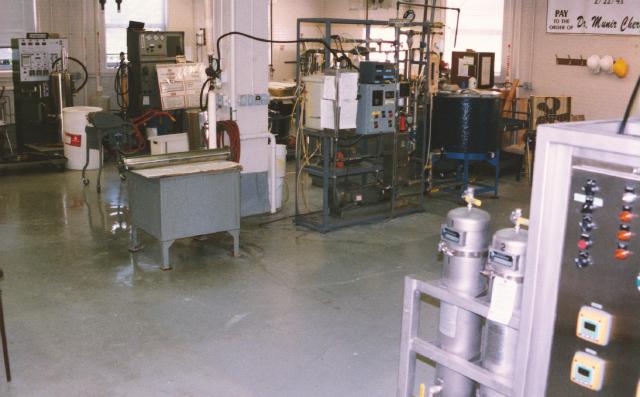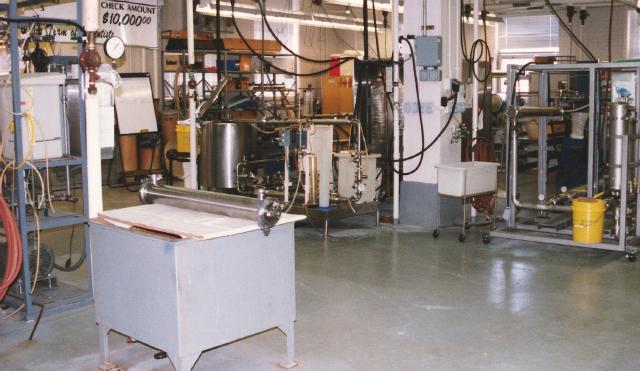Membrane Technology
Membrane technologies studied include reverse osmosis (RO), nanofiltration (NF), ultrafiltration (UF), microfiltration (MF), pervaporation (PV) and electrodialysis (ED).
In addition, we were among the first to begin a formal graduate course in membrane technology, intensive industry-oriented short courses on campus and other locations world wide and training of graduate students, post-doctoral fellows and visiting scientists sponsored by international agencies and companies. A modern 4000 square foot facility, which includes laboratories for chemical and microbiological work, computing facilities, office space and a 2000 square foot pilot plant, is devoted to this activity in the Agricultural Bioprocess Laboratory on the campus. There are several bench-top test cells for membrane screening and characterization using samples as small as 25 mL,and several pilot scale units that are used for scale-up and engineering studies that can handle several hundred liters per day. These include hollow fiber, spiral wound and tubular membrane designs in a variety of membrane materials (e.g., polymeric, ceramic, stainless steel). Pre- and post-treatment facilities are in adjacent buildings with over 1150 square meters (12,500 square feet) of process equipment (spray driers, drum driers, tray driers, freeze driers, evaporators, extruders, grinders, homogenizers, continuous centrifuges, milling machines, batch and continuous heat exchangers for heating, cooling and freezing, etc.). This allows us to take an integrated process approach to projects if necessary.
The membrane technology and
bioprocessing pilot plant at the University of Illinois. This is one of three pilot plants in
the department that total 1400 square meters (15,000 square feet).
1. PROCESS DEVELOPMENTAn example of this approach is our early work on the manufacture of purified functional food ingredients and other value-added bioproducts from a variety of raw materials. For example, the relatively high quantity and quality of protein and fat make soybeans a valuable raw material for the manufacture of the protein isolates and other products that can be used in the formulation of a variety of nutritious foods. For optimum soybean utilization, certain off-flavor factors and anti-nutritional compounds must be reduced or eliminated, while maximizing yields and minimizing loss of functional properties. We have developed a process using ultrafiltration that meets these objectives. By careful selection of membrane and operating conditions, the undesirable components can be selectively removed. Since no heat is required and no phase change occurs, the process is low in energy and minimizes thermal damage to soybean constituents. Further, the whey proteins, normally lost in conventional isolate manufacture, is retained in the final product, which increases yields as well as improves functional properties. Full-fat soy protein concentrates are produced from whole soybeans after appropriate pre-treatment, while soy isolates are produced from defatted soy meal.Functional properties of these products have been studied and are superior to conventional
soy-products in some respects, especially solubility and dispersibility, emulsification and
whipping. The emulsion stability at acidic pH makes it particularly useful in mayonnaise-type
products, and they can also be used to produce a smooth, tasty and nutritious imitation milk. Corn (maize) protein isolates and concentrates can also
be produced by membrane technology. A combination of solvents such as ethanol to extract the zein
and alkali to extract the glutelin is used with the appropriate membranes.
Corn protein hydrolyzates with improved functional properties have
been produced using enzymes and membrane separations.
The binding of sunflower protein to polyphenols was studied using ultrafiltration.
This provided an understanding of the nature and extent of binding of undesirable polyphenols,
which was useful in developing a process to manufacture sunflower protein isolates and
concentrates. Milk and cheese whey protein concentrates and isolates have
been a focus for more than three decades. Membrane technology allows the separation and
isolation of dairy proteins in a manner that frequently results in superior and unique
functional properties. One of the earliest successful applications of ultrafiltration, it
is a good example of converting an otherwise tremendous source of pollution into useful
products. Cheese whey is notorious for severely fouling membranes. A vast amount of research
over a period of 10 years has resulted in a better understanding of the problem and methods to
minimize these effects. Today, membrane processing of cheese whey is a well-accepted standard
unit operation in the dairy industry around the world.
BioprocessingMembranes can be valuable in biotechnology applications, especially downstream processing. We have focused on four aspects:
"Bioreactors" refer to equipment wherein biological substances undergo a chemical change in the presence of a biological catalyst such as an enzyme or microorganism. Traditionally, this has meant using "batch" reactors or fermenters, which has disadvantages such as high capital and labor costs, inconsistent products (batch to batch variation), the expense of separating and inactivating the biocatalyst at the end of the process and low productivity (defined as amount of product per unit reactor volume per unit time). An alternate approach has been used in our laboratory at the University of Illinois for designing high-performance bioreactors, specifically for enzymatic and microbial conversion processes. Membrane separation modules, of the appropriate chemical nature and physical configuration, are incorporated into the overall reaction process in one of two configurations: the CSTR (recycle) bioreactor or the PFR (hollow fiber) bioreactor. Applications studied to date include:
2. MEMBRANE CHARACTERIZATION AND EVALUATIONAt present, no work is being done on the manufacture of the membranes or the fabrication of the modules. This area of research focuses on testing and evaluating new membranes and/or modules developed by companies and other research organizations. Potential users of membrane technology find this service particularly useful if membranes are new to them, or if they wish to reduce the risk when the process is commercialized, or as proof of concept or to keep up with new developments in membrane science. The exact nature of the testing depends on the potential application, e.g., minimizing capital equipment costs, reducing energy consumption or waste or recovery and recycling effluents.3. ENGINEERING OPTIMIZATIONOur work in this area centers around understanding the effect of major process variables (e.g., pressure, temperature, flow rate, concentration, pH) on the key factors affecting the performance of membrane systems (flux and rejection). Mathematical models, based on semi-empirical and classic momentum and mass transfer correlations, are developed for specific MF, UF, NF, RO and PV applications. Of special interest is the behavior of colloidal feed streams, which are typical of many food and biological systems, which tend to give experimental fluxes much higher than predicted by classic mass transfer models.Two areas of special concern are membrane fouling (and cleaning) and energy consumption characteristics of various membranes and modules. The fouling phenomenon has been studied using model and real systems. X-ray analysis and electron microscopy of the fouled membrane elucidated the nature and extent of the interactions between feed components and the membrane. This was valuable in developing feed pre-treatments and recommendations to minimize membrane-solute interactions. Studies are also being done on the effect of membrane module design and operating conditions on the fouling phenomenon. The ultimate goal is to design the optimum membrane process. We have a close relationship
with several membrane manufacturers and engineering companies. This enables us to provide good
estimates of capital and operating costs to project sponsors, with data obtained in our pilot
plant using commercial scale modules in most cases. This can substantially reduce the time
and risk for potential users of the technology.
 Research Research
 Main Page Main Page
Updated July 2009 |


